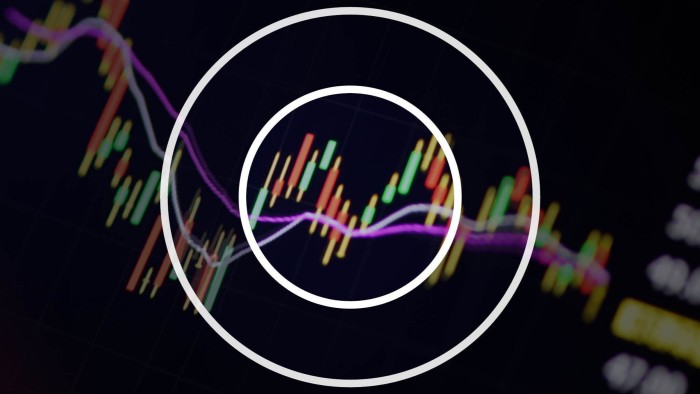Meet the fastest growing ETF firms in the US

Simply sign up to the Exchange traded funds myFT Digest -- delivered directly to your inbox.
Just three providers control about 75 per cent of the assets in US exchange traded funds these days: BlackRock, Vanguard, and State Street Global Advisors. But, beyond these dominant players, dozens of other asset managers — big and small — are waging an increasingly intense battle for the remaining quarter of the $8tn ETF market.
And many of those smaller fish are active managers looking to attract the wave of investor dollars seeking an alternative to the predominantly passive strategies offered by the Big Three firms.
They have reason to fancy their chances. Although the rise of passive funds, at the expense of active stockpickers, has continued in the broader asset management industry, actively managed ETFs have been punching above their weight.
Active ETFs took in about $106bn last year, or 18 per cent of the US ETF industry’s $576bn in net new money in 2023 — well above their average 6 per cent market share, according to data from Morningstar Direct. By contrast, actively managed mutual funds lost $469bn to investor redemptions.
These inflows have helped smaller ETF providers get a lot bigger: the 10 fastest growing US ETF issuers had, by the end of 2023, accumulated just under $400bn between them, or more than 5 per cent of the market — a huge leap from less than $30bn, or not even 1 per cent, at the start of 2019, according to Morningstar.
With BlackRock and State Street shedding market share in recent years, there has been plenty of unexplored territory for active managers to exploit.
Two such managers, Dimensional Fund Advisors and Capital Group, have launched entirely new ETF franchises. JPMorgan has taken a $20bn ETF arm and grown its assets well above $100bn. Ark Investment Management generated stellar results in 2020, which helped it amass investor assets. Pacer Funds, meanwhile, has issued a suite of so-called cash cow ETFs that invest in companies with excess cash flow. This has enabled it to increase its assets by more than 800 per cent since the start of 2019.
“We didn’t want to be the same kind of ETF company as the State Streets and Vanguards of the world, where there’s plenty of what you would call ‘cheap beta’ out there,” says Sean O’Hara, president of Pacer ETFs. “To go head-to-head with those folks — they had such significant scale advantages — just didn’t make any sense.”
Another smaller firm that has gained traction is Innovator Capital Management, which had grown its assets from less than $1bn in 2019 to about $17.5bn by the end of 2023. The firm specialises in “defined outcome”, or buffered, ETFs that use derivatives to hedge against falling markets — trading maximal returns for downside protection. Innovator is now seeking to expand beyond its core audience of registered investment advisers by gaining traction on larger platforms, explains Graham Day, the company’s chief investment officer.
“The vast majority of platforms are still doing their due diligence on buffered ETFs,” Day says. “But we’re slowly seeing the domino effect going into motion on a few of these distribution platforms in onboarding these ETFs. We know there’s a tremendous amount of pent-up demand within these channels for these products.”
Mutual fund company Capital Group has amassed about $21bn in ETF assets since 2022 with a different approach: focusing fund launches on categories such as core bonds, income and dividend yield. Its aim is to unlock “sticky” money in the actively managed fixed income space, explains Holly Framsted, head of global product strategy and development at the firm, which has long been known for its American Funds franchise.
“When we look at where the growth is coming from, a vast majority of the assets are net new to Capital Group,” she says. “They are not coming from our mutual fund line-up. What that tells me is that there are portions of existing clients of the American Funds that had moved to ETFs . . . outside the firm, and we [now] believe those assets are coming back.
“And there are financial advisers who have migrated their entire business model to be ETF-centric, who have perhaps moved away from having a relationship with our organisation — [and] those advisers are also coming back.”
Dimensional, which has experienced sizeable outflows from its mutual fund business in recent years, jump-started its ETF franchise in 2021 by converting the first of seven existing funds into ETFs. Since then, it has steadily grown its ETF business through organic launches and by attracting new net cash. As a result, ETFs now make up $120bn of Dimensional’s $677bn overall assets under management.
“It’s not like we’re doing something completely different in the ETFs,” says Rob Harvey, co-head of product specialists at Dimensional. “We’re taking what worked well in the mutual funds and finding a way that it can be just as effective in an ETF.”
JPMorgan’s recent success in the sector has rested on its covered call ETFs, namely JPMorgan Equity Premium Income (JEPI), which has attracted more than $32bn in assets since its May 2020 launch. Covered call ETFs generate income by writing and selling options on their underlying holdings — in JEPI’s case, large-cap stocks in the S&P 500. JPMorgan has also had success with similar income-generating products tied to the Nasdaq 100 and various types of debt, such as the $22bn JPMorgan Ultra-Short Income ETF.
“We’re starting to find our sea legs a little bit as an ETF issuer,” explains Bryon Lake, global head of ETFs for JPMorgan Asset Management. “The industry has really embraced active ETFs, and we have leaned in heavily.”

Comments